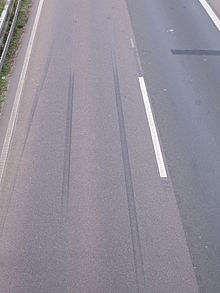Stutter brake
With intermittent brake repeated short actuation and release is the fast service brake the vehicle referred. Before the introduction of the anti-lock braking system , the stutter brake was of particular importance. The ability to steer could thus be largely maintained when braking on ice and snow.
history
In 1958, the guidelines for the training of driving instructors were the first to list “what to do in the event of emergency braking, in particular how to avoid locking the wheels and what to do when locking the wheels” for driving license training . The ADAC recommended the stutter brake in the 1960s . Thereafter, in the event of an emergency braking, the wheels should be brought into the locking area with a strong kick and then the braking force should be released in order to maintain the ability to steer. In the event of emergency braking, however, the official driver's license test stipulated "only braking so hard that the wheels do not lock if possible, neither on a slippery nor a dry road."
It was not until the 1970s that the stutter brake came under criticism as a braking distance extender. In this context, Rauno Aaltonen spoke of the “fairy tale of stuttering”.
"The rolling phases of the car between braking and not braking lengthen the braking distance [...], when the brakes are released, too much braking distance is wasted."
While the car driver can press and release the brake a maximum of two times in one second in a normal situation, rally drivers like Rauno Aaltonen showed that this is possible up to six times in one second.
In dangerous situations, however, the stutter brake method failed due to the "lack of practice" of normal drivers.
“When it comes to emergency braking, the driver is under extraordinary stress. He steps on the brake pedal and is incapable of any other reaction. "
From 1978 anti-lock braking systems (ABS), "automatic stuttering brakes", were introduced into series production. Since July 2004, all newly registered cars in Germany have been fitted with ABS as standard; The stutter brake with the foot is in any case pointless with these vehicles. The electronics can recognize the steep drop in the wheel circumferential speed shortly before the wheel locks much faster and correct it more precisely than a human.
The traffic law used the term stutter brake in a judgment of the Higher Regional Court Hamm (6 U 167/90) also in a different meaning. In the given case, turning right into a property must be indicated not only with the indicator but also by tapping the brake several times ("stuttering brake"), it says.
literature
- Rauno Aaltonen : Revolution at the wheel, the new driving technique. BMW AG, 1981.
- Hans-Rolf Reichel: Electronic brake systems. From ABS to brake-by-wire . Expert Verlag, 2001, ISBN 3-8169-2010-1 .
- Konrad Reif: Driving stabilization systems and driver assistance systems. Vieweg and Teubner Verlag, 2010, ISBN 978-3-8348-1314-5
Individual evidence
- ↑ a b Konrad Reif, p. 147.
- ↑ a b Safe travel on ice and snow . dekra.net; Retrieved May 7, 2016
- ↑ See VkBl. 22/1958 of November 12, 1958. In: Walter Weißmann: Chronicle of driving instructor law regulations . Mobil-Verlag Hilgertshausen, 2008, ISBN 978-3-935580-03-8 , p. 399.
- ↑ a b c Hans-Rolf Reichel, p. 26.
- ↑ The big ADAC car book . Verlag Das Beste Stuttgart, 1976, ISBN 3-87070-092-0 , pp. 312, 331.
- ↑ The driver of today. Training and examination for the driving license . Emergency braking: 16.22. Verlag Heinrich Vogel, Munich, 1969, p. 109.
- ↑ Doom on stuttering . In: Der Spiegel . No. 34 , 1977, pp. 148-149 ( online ).
- ↑ Rauno Aaltonen, p. 32.
- ↑ Brake pressure build-up (brake response and brake threshold time) <0.4 seconds according to ECE regulation 13.
- ↑ Rauno Aaltonen, p. 34.
- ^ OLG Hamm v. 11/29/1990: Liability distribution when swinging to the left when entering a property to the right
